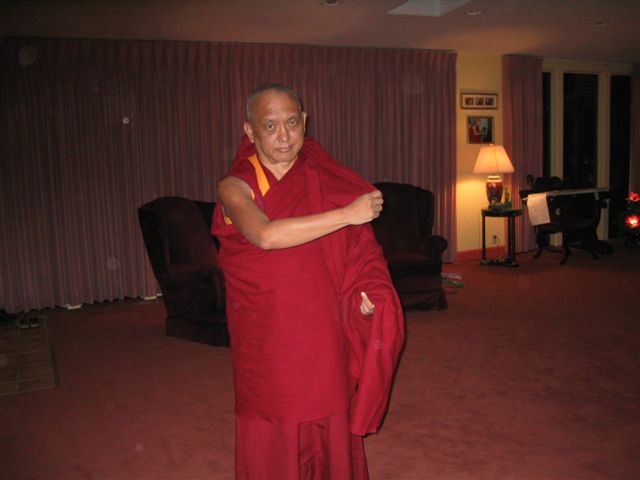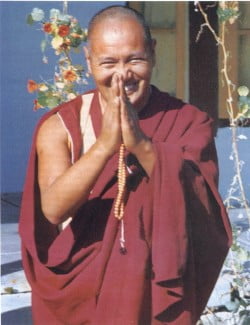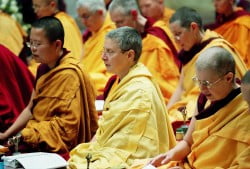Sangha Dress Code
By Lama Zopa Rinpoche
While Lama Zopa Rinpoche and some students were sitting in a restaurant, a waiter remarked that he liked Rinpoche’s robes very much. He asked where he could get some and Rinpoche replied that he could get them in Nepal or India. The waiter replied that he wanted to go there to buy some.
After the waiter left, Rinpoche commented that it was due to Dharma imprints that the waiter liked the robes. It was an example of how, while traveling, one meets some people who like and some people who have a strong reaction against the robes. Rinpoche then told the story of a small boy in an airport who kept looking at him. The boy’s father did not like his son looking at Rinpoche so he turned his son’s head away. Rinpoche explained that, due to Dharma imprints, some people like robes, and that possibly, in a past life, the boy had been a Tibetan monk or Tibetan Buddhist, having respect for the robes. Rinpoche started to give the following advice in the restaurant and continued later in at his house in Aptos.
I want to emphasize how important it is to wear robes properly because people’s devotion and interest, being drawn to Buddhism, to the Dharma, planting the seed of liberation and full enlightenment, depends on how you behave. This includes how you wear the robes—correctly, neatly, nicely.
If others see sangha as very compassionate, kind, and warm-hearted, not ignorant but having discriminating wisdom and Dharma education, they are drawn to them. They are impressed by the clarity of Buddhism, which is difficult to find in other religions. If you are wearing messy robes, people will not like it; they might think it is a sign that the person has a messy mind and a confused life. So, it is important to wear the robes neatly and correctly.
In Tibet and Nepal, one can wear old tattered robes, because it is a different world. But one should wear good robes in the west, not tattered but neat, so that it doesn’t create a bad reputation for Buddhist nuns and monks, giving people a negative idea that they are strange, instead of rejoicing at their behavior. One shouldn’t wear the robes sloppily, looking messy.
I remember, in England, somebody tried to meditate in a cave, and the people thought there was something wrong with that person’s mind; they interviewed the person and thought their mind had gone wrong, rather than seeing the quality of an incredible person with strong determination and renunciation, giving up the desire of clinging to this life—a very important fundamental practice.
Renunciation is the greatest quality to clear the obstacles to the attainment and continuation of Dharma practice, but that is not known in the west—people think there is something wrong with you if you have this, that you are unable to live in Western society. Their view of a good life is getting married, having children, and living in a luxury home, with a highly paid job; they cannot think of anything higher. Anything higher than that—up to liberation and enlightenment—is unknown, doesn’t exist.

If you want to wear warm things such as pullovers, you should wear them inside the dongka; wearing them outside looks messy. If one person wears it outside, then another person sees it, then another, and many people take it as an example. Sleeves are normally a part of lay dress, which we take vows not to wear, but if one is sick there is probably permission to do this. Being cold is not a reason to wear sleeves. If you do this you will get habituated to it, like some people have.


If you have a long zen you can hold the right side of the zen on the left and bow. If you only have a short zen obviously you can’t do that as there would be no zen left on half of the body! It’s OK, as long as you don’t wrap the zen around your neck. As you sit in teachings you can spread the long part across your lap and hold your hands respectfully in your lap, the right hand loosely held by the left. You can still sit in front of senior monks with your hands in the respectful position.

It is explained in the 50 Verses of Guru Devotion and in the discussion in Liberation in the Palm of Your Hand how to listen correctly to teachings, both physically and mentally. Leaning on walls etc., sitting disrespectfully, stretching your legs out toward the guru or altar, even stretching the legs out in the presence of the guru, is disrespectful, no matter where they are pointing. Also, hugging the knees is disrespectful. On certain occasions, such actions are allowed. If one is traveling, going on pilgrimage, or sleeping in the same room as others, there is permission to do these things. It doesn’t mean one has to sleep sitting upright with one’s legs crossed! Also, there is permission from Buddha for exceptions to be made for sick people. If one is sick, there is no choice, and one can ask for permission—it is not rigid.
Of course, this doesn’t apply only to sangha; if you are respectful to the guru, to statues, stupas, and scriptures, you don’t create heavy negative karma. Also, this applies not only in a guru-disciple relationship; the same applies in the presence of any higher beings, statues, stupas, or scriptures, or with elder, higher sangha—even if they are not actually talking to you.
I think many people don’t know or don’t remember these points so I thought to mention them. There might be other things that are disrespectful without one knowing, but these are what I will mention for now.
Also, I have heard that some sangha wear lay dress when traveling. I don’t know that this is a good idea. It is against the vow you took. When you took the getsul vows, you took five “definite” vows that continue until the time of death; these vows don’t say “Only wear the robes in the monastery, when you travel you don’t have to wear the robes.” The vow wasn’t made that way; it was for all the time. The vow to not separate from the robes is the morality of the intermediate ordination of renunciation, renouncing the lay signs and customs, and always wearing robes. The vow was made at that time.
If you wear robes it educates those who do not know the robes of Buddhist monks and nuns, particularly Tibetan Buddhists. It is like advertising. The best, most inspiring image that people come to know is that Buddhism is something that doesn’t harm others, that benefits and brings peace to others; something that offers wisdom and compassion, not demanding blind faith; something very profound and deep.
Many monks from different monasteries have come to the west on tours, well prepared as good examples, performing religious dances, etc. I heard many people were inspired by their behavior and that people got a good feeling from them as being knowledgeable, peaceful, and kind. Western people were very impressed; this makes them interested in Buddhism. Of course, the monks are chosen by the monastery, not anyone can go, they are selected. For example, the Drepung Loseling monks did the first tour of Brazil. After their tour of religious dances, etc., many people were inspired, and I heard from our study groups and centers in Brazil that after that tour more people came to learn meditation.
If you are traveling, wearing the robes neatly and properly, and people see you as kind, compassionate, and educated, not having an ignorant, blind, thick-skulled mind, but having wisdom, there are many benefits, one of which is to educate the world about Buddhists—particularly Tibetan Buddhists—monks and nuns.
My experience when traveling is that from time to time people who have no connection with Dharma, have negative imprints, or maybe are religious extremists may get upset, but I know also many times people get inspired when they see someone wearing robes and definitely they think it is special. So, they collect a lot of merit and plant the seed of enlightenment through their interest.
For example, in the constitution of Takpo Shedupling Monastery, the monastery of Pabongka Dechen Nyingpa’s guru, Takpo Rinpoche, which is in Tibet on the way to Lhamo Lhatso, it is mentioned that because lay people have to carry very heavy loads when they travel and their lives are very hard, when they see a monk dressed in neat and clean robes, not carrying huge loads like themselves, they see him as having freedom; they are very impressed and feel devotion. This plants a seed of liberation in their minds. So, there is much benefit; it causes them to create the cause to become sangha, to remember Buddhism, to live in the vows, and to follow the path to liberation and enlightenment.
A similar example is of Buddha’s main disciple, Sharipu, who had so many opportunities to be with Buddha because of what happened in one of his past lives, when he was traveling and stopped overnight in a house. While he was fixing his shoes he noticed on the wall of his room a painting of a buddha, which he thought was very beautiful. He continued fixing his shoes and again looked at the painting thinking how beautiful it was. Because of that cause, in his next life he was able to be Buddha’s heart disciple, Sharipu, who was very wise, and had the opportunity to be with the Buddha.

You can benefit many sentient beings so much, even with your excellent behavior; you can bring them to liberation and enlightenment through proper behavior. Think of this as part of the practice, not with ego, the eight worldly dharmas, but thinking, “This is my way of liberating sentient beings and bringing them to enlightenment.”
For example, there is one arhat called Pakpa Tathul. Through his excellent behavior many sentient beings received incredible benefit, and their minds were tamed. So many sentient beings’ minds were pacified of delusions and became subdued because of his excellent behavior. He helped many sentient beings achieve realizations.
Colophon
Reprinted with permission from Lama Yeshe Wisdom Archive. For further information, please visit www.LamaYeshe.com



